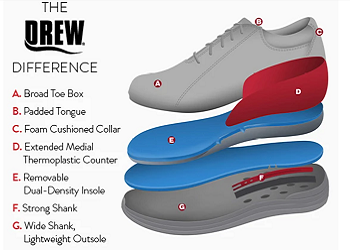Foot Conditions
Many people underestimate the importance of healthy feet. Some people simply neglect foot health, until they have a problem that requires professional help. Don’t be one of them. On these pages you will learn:
- how to recognize common conditions
- how to avoid some of them
- how to resolve or treat the others
While you might realize that your feet hurt, you may not realize that these conditions, if not promptly treated can also cause, aggravate or lead to:
- knee pain
- hip pain
- lower back pain
- fatigue
- poor athletic performance
- poor self image
- quality of life issues (sadness, depression)
- amputation (in the case of improper diabetic foot care and diabetic neuropathy)
In fact, some people consult their physician concerning another issue, only to learn that the real problem is in their feet. Taking good care of your feet helps you take care of the rest of your body and your emotional health, too.
The topics listed below are among the most common foot care issues. A brief overview of each topic is including on this page. Each subject is covered in greater detail on other pages of this website. Knowledge is often the key to good health. So, here’s the knowledge that you need to have healthy feet for life.
Achilles Tendonitis
An inflammation of the Achilles tendon, this condition often affects runners and other athletes. If not treated properly, it can lead to chronic pain. The condition begins with small tears that cause only minor pains that are easily ignored or overlooked. If the tearing continues, the leg may become weaker, the tendon may thicken, nodules may form, a rupture could occur and surgery may be needed for a complete recovery. You can learn how to prevent this kind of injury, recognize the early symptoms and treat them, in order to avoid complications. Read more about Achilles Tendonitis
Arch Pain & Flat Feet
Sometimes, people are born with flat feet, but in other cases, they develop during adulthood, usually due to injury or continuous stress on the arch. The height of a person’s arch may vary from low to high, with neither causing pain nor affecting athletic ability. However, the development of flat feet in later life is often accompanied by arch pain. Arch pain can be caused by many things, including poorly fitting shoes. Treatment usually involves rest and the use of insoles. Some shoe designs are better suited for people with flat feet. Some styles may even prevent the condition. Read more about Arch Pain & Flat Feet
Ball-of-foot Pain
Pain in the ball of your foot would be diagnosed as metatarsalgia, if the pain occurs where your largest or second largest toe meets the rest of your foot. In colloquial terms it is sometimes referred to as a “stone bruise”. Many different injuries can cause pain of this type, as can poorly fitting shoes. Chronic pain in the area may indicate that a bunion (covered below) is forming. Women that wear high heels, some runners and ballet dancers are the most common victims of this type of pain. But, anyone could suffer from it, occasionally. Read more about Ball-of-Foot Pain
Bunions
A bunion is actually a deformity of the joint at the base of your big toe. The bones or tissues surrounding the joint become enlarged, causing the joint to point outward and the toe to point inward. There may be a genetic tendency towards the development of a bunion, but poorly fitting shoes play a major role. Orthotics or surgical correction is sometimes needed, although wearing the proper shoes can prevent the condition from worsening and delay or prevent the need for additional treatment. You can learn more about these things on The Bunion Page.
Charcot Foot
Charcot “foot” may be a hereditary condition or a complication of diabetes. There is a characteristic appearance to the feet that include hammertoes and a high arch. Pain in the feet ankles, knees and other parts of the lower body are symptoms of the condition. Ulcers sometimes develop on the ball of the foot, particularly in diabetics. Surgical and non-surgical treatments are available, depending on the severity of the condition and the amount of time that a person must spend standing. Charcot athropathy is the general term used by doctors. The hereditary disease may be referred to as CMT, HMSN, PMA or HSMN. As with other conditions affecting the feet, selecting proper footwear is essential to lessen pain and improve mobility. For a more complete description of the characteristics, as well as additional information visit the Charcot Foot Page
Chondromalacia or Runner’s Knee
Chondromalacia patella and runner’s knee are old terms used to describe non-specific pain in the front of the knee, typically under the kneecap. Depending on your doctor’s age, you may hear either of those terms or patellofemoral syndrome, which is gradually replacing the old terminology. But, no matter what you call it, it’s a painful condition that may be preventable and is certainly treatable. The condition is included in this website about your feet, because poor foot care and/or poorly fitting shoes can cause knee pain, particularly in runners and other athletes. For additional insight into prevention and treatment of Chondromalacia or Runner’s Knee
Custom Orthotics
Custom orthotics for the feet may be fitted by a podiatrist, chiropractor, physical therapist or another medical doctor. There are many different items that fall under the category of orthotics, including shoe inserts and insoles. The term may also be used to indicate a device that is surgically implanted to provide additional support for a bone, joint or ligament following an injury. In some cases, the devices are removed once a fracture or other injury heals. In others, they are permanent implants. For more information about the different devices available and their uses visit the Custom Orthotics Page
Diabetic Foot Care
Whether you suffer from diabetes or care for someone that does, regular examination of the toes, nails and feet is essential. Diabetic foot care includes learning how to select appropriate cleansers, when to use moisturizers, when to keep the area dry, how to keep the nails clean and properly trimmed, about shoe selection, the benefit of special stockings and many other issues. All of those are covered in greater detail on the diabetic foot care page of this website. In diabetes, the feet reflect how well blood sugar levels are being controlled. The first symptoms of complications known as neuropathies typically occur in the feet. Read more about Diabetic Foot Care
Diabetic Neuropathy
Diabetic neuropathy is nerve and tissue death that occurs as a result of improperly controlled blood sugar levels or ineffective treatments. It is one of the most common complications of the disease. In some cases, it leads to partial or complete amputation. During the early stages, patients experience loss of feeling in all or part of their feet. Wearing properly fitting shoes, at all times, is essential to prevent injury that can go undetected and result in infections and ulcerations. Amputations are typically a last resort to prevent sepsis or blood poisoning. Learn more about Diabetic Neuropathy
Foot Corns & Calluses
Corns and calluses are some of the most common problems that people have with their feet. Yet, they are easily avoidable. They are caused by friction or pressure. A consistent rubbing such as would occur on the heel, toes or soft portions of the feet, due to improperly fitting shoes or simply bad designs. For example, women’s shoes that come to a point are fashionable, but her feet are not shaped that way. So, wearing the style on a regular basis typically leads to corns or calluses on the sides of her feet or in between her toes. Other causes, as well as preventative measures and treatments are covered on the Foot Corns and Calluses Page.
Foot & Heel Pain
Non-specific foot and/or heel pain can be a precursor to or accompany any of the problems mentioned here. When the pain is isolated in the heel section of the foot, the most likely cause is plantar fasciitis, which is discussed in its own section. Foot baths, massages and other recommendations for preventing and relieving these common aches and pains are listed on the Foot and Heel Pain page.
Foot Pain & Swelling
Foot pain and swelling can be a symptom of illness or disease, but more likely, it is a symptom of minor injury, such as a sprain. Rest, cold or warm compresses and keeping the feet elevated should reduce the swelling and the pain. The feet often swell during pregnancy and birth control pills can cause the problem. Any swelling that lasts for more than a few days should be evaluated by a physician. Learn more about Foot Pain & Swelling
Hammertoes
A hammer or mallet toe is a deformity of the joints in the second, third or fourth toes typically caused by wearing poorly fitted shoes (or those that are simply a bad design) that force the toes to remain in a curled or bent position for long periods of time. The deformity can also be a symptom of specific diseases, such as rheumatoid arthritis and it is one of the characteristics of Charcot foot, although that condition is typically accompanied by a malformation of the big toe, as well. In the early stages, hammertoes can be treated without orthopedic surgery. Learn how on the Hammertoes Page.
Heel Bursitis
Bursitis is inflammation or infection of the bursas, which are fluid filled sacs that act as cushions between bones and tendons or muscles and joints. The term heel bursitis might be used to describe inflammation of the bursa separating the Achilles tendon from the bones of the lower leg. The term might also be used to describe heel pain, when no specific cause can be identified. The condition could be acute or chronic and may be associated with other conditions, such as spurs. Read more about Heel Bursitis
Heel Spurs
Heel spurs are thin spiky calcifications that occur on the calcaneus, the long bone that forms the base of the rear of the foot; the heel. Spurs are detected through X-ray, although the ones that occur on the back of the bone can be “felt” through the skin. Although they are often painful, surgical removal of the spur is not usually needed, expect as part of the treatment of severe Achilles tendonitis. You can learn more about managing the condition and reducing the pain of spurs on our Heel Spur Page.
Hyperhidrosis
Although hyperhidrosis, which is excessive sweating, can occur on other parts of the body, the feet are usually involved. Even a person that does not perspire heavily on other body parts may experience excessively sweaty feet. One of the causes is the high concentration of sweat glands, but footwear plays a role, too. Some types of socks and shoes trap perspiration, which creates a perfect environment for bacteria and fungi. Keeping the feet dry through the use of appropriate foot-care products and footwear will reduce the sweating, the risk of infection and the odor. Learn more by about Hyperhidrosis
Ingrown Toenails
Onychocryptosis, commonly referred to as ingrown nails, can occur on the hands or feet, but are most common on the feet. As with many other foot problems, the most common cause is poorly fitting and/or poorly designed stockings and shoes. Pointy-toe designs, which squeeze the toes, and shoes that are too narrow, in general, as well as tight stockings apply pressure to the sides and tops of the nails causing them to grow into and cut the nail bed. Prevention is easier than treatment. A full page on this website is devoted to the prevention and home treatment of minor cases of ingrown toenails. Learn more about Ingrown Toenails
Morton’s Neuroma
Morton’s neuroma is a specific condition characterized by burning, pain and numbness of the feet that is relieved by removing the shoes. Many practitioners feel that it is over-diagnosed, as the same symptoms may be brought on by poorly fitting shoes. If the condition is actually Morton’s neuroma, a benign tumor is pressing on the nerves of the feet, the plantar nerves. Diagnosis can be difficult to make, as an MRI does not always reveal the soft tissue tumor. Most practitioners feel that surgery should be a last resort. On the Morton’s Neuroma page, you can learn how doctor’s can differentiate between the “real” condition and pain caused by other issues.
Overlapping Toes
Truly overlapping toes are rare, typically congenital abnormalities, but hammertoes may appear to overlap and cause put pressure on the normal toes. In Charcot foot, the big toe may lean against or overlap the second toe. The page devoted to overlapping toes covers what we know about the congenital abnormalities and the available solutions. Read more about Overlapping Toes
Plantar Fasciitis
Plantar fasciitis is the most common cause of heel pain and one of the most common foot problems, period. Millions of people every year see their doctor for this type of pain. The pain is usually felt on the underside of the heel and patients usually have trouble pointing their toes or flexing their feet upwards. It is common in athletes and common folks, alike. Anyone that spends a lot of time on their feet, without proper support can suffer. Being overweight contributes to the problem, but even if a person is overweight, the right kinds of shoes can help prevent the problem from recurring in the future. Learn more about Plantar Fasciitis
Sensitive Feet
In all actuality, everyone has sensitive feet and ankles that are easily injured. In each of our feet and ankles, there are over 20 different bones, more than 30 joints and over a hundred different muscles, tendons and ligaments. Being very ticklish on the bottoms of your feet is not unusual, but time, corns, calluses and neglect can result in less sensitive feet. When you think about how much work each of your feet must do every day, you realize that they have good reason to be achy. If your feet are very sensitive to things like seams in socks and on the insides of your shoes, you can buy footwear specially designed for you, without paying custom-made prices. Learn more about Sensitive Feet
If you suffer from any of the conditions on this page or any other health problems in the lower extremities such as like varicose veins, shin splints or weak ankles, we recommend you visit www.FootSmart.com to find a product specifically suited to your needs. Please consider how crucial it is to treat foot conditions before they degenerate into a more serious problem.
You can shop by condition or just browse their excellent selection of foot care products and treatment accessories.
Rest assured that after careful review of several online foot care sites, Foot Smart is the only site we recommend to our readers. They are dedicated “solely” to making your feet (and the rest of your body as a result) healthier and more comfortable. If you are in need of foot care and lower body health products, then Click Here to visit FootSmart.com.


